Art From the Indian Mughal Period Incorporated Visual Elements From Both Europe and

From the delineation of Hindu gods, and other mythological characters, the Kalighat painting reflects a variety of subjects, including many depictions of everyday life.

Indian art consists of a variety of fine art forms, including painting, sculpture, pottery, and cloth arts such as woven silk. Geographically, it spans the unabridged Indian subcontinent, including what is at present Republic of india, Pakistan, Bangladesh, Sri Lanka, Nepal, and at times eastern Afghanistan. A strong sense of design is characteristic of Indian art and can exist observed in its mod and traditional forms.
The origin of Indian art tin exist traced to prehistoric settlements in the 3rd millennium BC. On its way to modern times, Indian art has had cultural influences, too as religious influences such as Hinduism, Buddhism, Jainism, Sikhism and Islam. In spite of this complex mixture of religious traditions, mostly, the prevailing artistic fashion at any fourth dimension and identify has been shared by the major religious groups.
In historic art, sculpture in rock and metal, mainly religious, has survived the Indian climate better than other media and provides most of the best remains. Many of the most important ancient finds that are not in carved stone come from the surrounding, drier regions rather than India itself. Indian funeral and philosophic traditions exclude grave goods, which is the primary source of ancient art in other cultures.
Indian artist styles historically followed Indian religions out of the subcontinent, having an especially large influence in Tibet, S Eastern asia and China. Indian fine art has itself received influences at times, particularly from Fundamental Asia and Iran, and Europe.
Early on Indian art [edit]
Rock art [edit]
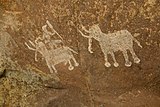

Rock art of Bharat includes stone relief carvings, engravings and paintings, some (but by no means all) from the S Asian Stone Historic period. It is estimated there are about 1300 rock fine art sites with over a quarter of a million figures and figurines.[one] The earliest rock carvings in Bharat were discovered by Archibald Carlleyle, twelve years before the Cavern of Altamira in Spain,[2] although his work only came to light much later via J Cockburn (1899).[iii]
Dr. 5. S. Wakankar discovered several painted stone shelters in Central India, situated effectually the Vindhya mountain range. Of these, the c. 750 sites making up the Bhimbetka rock shelters have been enrolled every bit a UNESCO Globe Heritage Site; the earliest paintings are some ten,000 years old.[4] [5] [vi] [seven] [8] The paintings in these sites commonly depicted scenes of human life alongside animals, and hunts with stone implements. Their fashion varied with region and age, but the well-nigh common characteristic was a red wash made using a powdered mineral chosen geru, which is a form of Atomic number 26 Oxide (Hematite).[9]
Indus Valley Civilization (c. 3300 BC – c. 1750 BC) [edit]

Despite its widespread and sophistication, the Indus Valley civilization seems to have taken no interest in public large-scale art, unlike many other early on civilizations. A number of gold, terracotta and stone figurines of girls in dancing poses reveal the presence of some forms of trip the light fantastic toe. Additionally, the terra cotta figurines included cows, bears, monkeys, and dogs.
Much the about mutual class of figurative fine art plant is small carved seals. Thousands of steatite seals have been recovered, and their physical graphic symbol is adequately consequent. In size they range from 3⁄4 inch to 1 1⁄2 inches square. In most cases they have a pierced boss at the back to suit a cord for handling or for use as personal adornment. Seals accept been found at Mohenjo-Daro depicting a figure standing on its head, and some other, on the Pashupati Seal, sitting cantankerous-legged in a yoga-like pose. This figure has been variously identified. Sir John Marshall identified a resemblance to the Hindu god, Shiva.[10]
The animal depicted on a majority of seals at sites of the mature period has non been clearly identified. Part bull, part zebra, with a royal horn, it has been a source of speculation. As yet, there is insufficient prove to substantiate claims that the image had religious or cultist significance, just the prevalence of the epitome raises the question of whether or non the animals in images of the IVC are religious symbols.[eleven] The most famous piece is the bronze Dancing Girl of Mohenjo-Daro, which shows remarkably advanced modelling of the human figure for this early date.[12]
Afterwards the terminate of the Is Valley Civilization, there is a surprising absence of art of any peachy degree of sophistication until the Buddhist era. It is thought that this partly reflects the use of perishable organic materials such as wood.[13]
Vedic menses [edit]

The millennium following the collapse of the Indus Valley Civilisation, coinciding with the Indo-Aryan migration during the Vedic menstruation, is devoid of anthropomorphical depictions.[14] It has been suggested that the early on Vedic religion focused exclusively on the worship of purely "simple forces of nature by means of elaborate sacrifices", which did non lend themselves easily to anthropomorphological representations.[fifteen] [16] Various artefacts may vest to the Copper Hoard Culture (2nd millennium BCE), some of them suggesting anthropomorphological characteristics.[17] Interpretations vary as to the exact signification of these artifacts, or even the culture and the periodization to which they belonged.[17] Some examples of creative expression also announced in abstract pottery designs during the Blackness and cherry-red ware culture (1450-1200 BCE) or the Painted Grey Ware culture (1200-600 BCE), with finds in a broad expanse, including the area of Mathura.[17]
Later a gap of near a k years, most of the early finds correspond to what is chosen the "2nd period of urbanization" in the middle of the 1st millennium BCE.[17] The anthropomorphic depiction of various deities manifestly started in the center of the 1st millennium BCE, possibly as a outcome of the influx of foreign stimuli initiated with the Achaemenid conquest of the Indus Valley, and the ascension of alternative local faiths challenging Vedism, such as Buddhism, Jainism and local popular cults.[14]
Mauryan fine art (c. 322 BCE – c. 185 BCE) [edit]

The north Indian Maurya Empire flourished from 322 BCE to 185 BCE, and at its maximum extent controlled all of the sub-continent except the extreme southward as well equally influences from Indian ancient traditions, and Ancient Persia,[18] as shown past the Pataliputra capital.
The emperor Ashoka, who died in 232 BCE, adopted Buddhism about half-fashion through his 40-year reign, and patronized several big stupas at key sites from the life of the Buddha, although very trivial decoration from the Mauryan period survives, and there may non have been much in the beginning identify. There is more from various early sites of Indian rock-cut architecture.
The most famous survivals are the large animals surmounting several of the Pillars of Ashoka, which showed a confident and boldly mature style and craft and get-go of its kind iron casting without rust until date, which was in use by vedic people in rural areas of the land, though we have very few remains showing its development.[xix] The famous detached Panthera leo Capital of Ashoka, with four animals, was adopted as the official Emblem of Bharat after Indian independence.[xx] Mauryan sculpture and compages is characterized by a very fine Mauryan polish given to the stone, which is rarely found in afterwards periods.
Many small pop terra cotta figurines are recovered in archaeology, in a range of oft vigorous if somewhat crude styles. Both animals and human figures, normally females presumed to be deities, are found.[21]
Colossal Yaksha statuary (2nd century BCE) [edit]

Yakshas seem to have been the object of an of import cult in the early on periods of Indian history, many of them being known such equally Kubera, male monarch of the Yakshas, Manibhadra or Mudgarpani.[23] The Yakshas are a broad class of nature-spirits, usually benevolent, merely sometimes mischievous or capricious, connected with water, fertility, copse, the forest, treasure and wilderness,[24] [25] and were the object of popular worship.[26] Many of them were later on incorporated into Buddhism, Jainism or Hinduism.[23]
In the 2nd century BCE, Yakshas became the focus of the creation of colossal cultic images, typically around 2 meters or more in height, which are considered as probably the first Indian anthropomorphic productions in rock.[27] [23] Although few ancient Yaksha statues remain in good condition, the vigor of the style has been applauded, and expresses essentially Indian qualities.[27] They are frequently pot-bellied, two-armed and fierce-looking.[23] The Yashas are often depicted with weapons or attributes, such as the Yaksha Mudgarpani who in the correct paw holds a mudgar mace, and in the left hand the figure of a pocket-sized continuing devotee or kid joining hands in prayer.[28] [23] It is often suggested that the style of the jumbo Yaksha statuary had an important influence on the cosmos of later divine images and human figures in India.[29] The female person equivalent of the Yashas were the Yashinis, often associated with trees and children, and whose voluptuous figures became omnipresent in Indian art.[23]
Some Hellenistic influence, such every bit the geometrical folds of the drapery or the walking stance of the statues, has been suggested.[27] Co-ordinate to John Boardman, the hem of the dress in the monumental early on Yaksha statues is derived from Greek fine art.[27] Describing the mantle of one of these statues, John Boardman writes: "Information technology has no local antecedents and looks most similar a Greek Late Archaic mannerism", and suggests it is possibly derived from the Hellenistic art of nearby Bactria where this pattern is known.[27]
In the production of colossal Yaksha statues carved in the round, which can exist institute in several locations in northern India, the art of Mathura is considered equally the nearly advanced in quality and quantity during this period.[30]
Buddhist art (c. 150 BCE – c. 500 CE) [edit]

Crossbar medallion with elephant and riders, Mathura art, circa 150 BCE.[31]
The major survivals of Buddhist art begin in the period afterward the Mauryans, from which good quantities of sculpture survives. Some key sites are Sanchi, Bharhut and Amaravati, some of which remain in situ, with others in museums in Republic of india or around the world. Stupas were surrounded past ceremonial fences with four profusely carved toranas or ornamental gateways facing the cardinal directions. These are in stone, though clearly adopting forms developed in wood. They and the walls of the stupa itself can be heavily busy with reliefs, mostly illustrating the lives of the Buddha. Gradually life-size figures were sculpted, initially in deep relief, but then free-standing.[32] Mathura was the nearly important centre in this development, which applied to Hindu and Jain art too every bit Buddhist.[33] The facades and interiors of rock-cut chaitya prayer halls and monastic viharas accept survived better than like free-continuing structures elsewhere, which were for long mostly in woods. The caves at Ajanta, Karle, Bhaja and elsewhere incorporate early sculpture, oftentimes outnumbered by later works such as iconic figures of the Buddha and bodhisattvas, which are non found before 100 CE at the to the lowest degree.
Buddhism adult an increasing emphasis on statues of the Buddha, which was greatly influenced by Hindu and Jain religious figurative art, The figures of this period which were as well influenced past the Greco-Buddhist art of the centuries afterward the conquests of Alexander the Neat. This fusion developed in the far north-westward of India, especially Gandhara in modern Afghanistan and Islamic republic of pakistan.[34] The Indian Kushan Empire spread from Fundamental Asia to include northern India in the early centuries CE, and briefly deputed large statues that were portraits of the royal dynasty.[35]
Shunga Dynasty (c. 185 BCE – 72 BCE) [edit]

The Nifty Stupa at Sanchi, c. 273 BCE – 232 BCE (Mauryan Empire), enlarged c. 150 BCE – 50 BCE (Shunga Dynasty)
With the fall of the Maurya Empire, control of India was returned to the older custom of regional dynasties, one of the most significant of which was the Shunga Dynasty (c. 185 BCE – 72 BCE) of key India. During this period, likewise equally during the Satavahana Dynasty which occurred meantime with the Shunga Dynasty in southward Republic of india, some of the about significant early Buddhist architecture was created. Arguably, the most significant architecture of this dynasty is the stupa, a religious monument which usually holds a sacred relic of Buddhism. These relics were often, but not ever, in some manner straight connected to the Buddha. Due to the fact that these stupas contained remains of the Buddha himself, each stupa was venerated every bit being an extension of the Buddha's body, his enlightenment, and of his achievement of nirvana. The fashion in which Buddhists venerate the stupa is by walking around it in a clockwise manner.[36]

A monumental rock-cutting cave, the Not bad Chaitya at Karla Caves, congenital circa 120 CE
One of the most notable examples of the Buddhist stupa from the Shunga Dynasty is The Bully Stupa at Sanchi, which was thought to exist founded by the Mauryan emperor Ashoka c. 273 BCE – 232 BCE during the Maurya Empire.[37] The Bully Stupa was enlarged to its present diameter of 120 feet, covered with a stone casing, topped with a balcony and umbrella, and encircled with a stone railing during the Shunga Dynasty c. 150 BCE - 50 BCE.
In addition to architecture, another meaning art form of the Shunga Dynasty is the elaborately moulded terracotta plaques. As seen in previous examples from the Mauryan Empire, a way in which surface detail, nudity, and sensuality is continued in the terracotta plaques of the Shunga Dynasty. The most common figural representations seen on these plaques are women, some of which are thought to be goddesses, who are mostly shown equally bare-chested and wearing elaborate headdresses.[38]
Satavahana dynasty (c. 1st/tertiary century BCE – c. third century CE) [edit]
The Satavahana dynasty ruled in central Bharat, and sponsored many large Buddhist monuments, stupas, temples, and prayer-halls, including the Amaravati Stupa, the Karla Caves, and the outset stage of the Ajanta Caves.[39]

Stupas are religious monuments built on burial mounds, which contain relics beneath a solid dome. Stupas in unlike areas of India may vary in structure, size, and design; still, their representational meanings are quite similar. They are designed based on a mandala, a graph of cosmos specific to Buddhism. A traditional stupa has a railing that provides a sacred path for Buddhist followers to practice devotional circumambulation in ritual settings. Also, ancient Indians considered caves as sacred places since they were inhabited by holy men and monks. A chaitya was constructed from a cave.[36]
Relief sculptures of Buddhist figures and epigraphs written in Brahmi characters are often found in divine places specific to Buddhism.[xl] To celebrate the divine, Satavahana people also fabricated stone images as the ornament in Buddhist architectures. Based on the knowledge of geometry and geology, they created platonic images using a set of complex techniques and tools such as chisels, hammers, and compasses with atomic number 26 points.[41]
In addition, delicate Satavahana coins show the capacity of creating art in that menstruation. The Satavahanas issued coins primarily in copper, lead and potin. Later on, silvery came into use when producing coins. The coins usually have detailed portraits of rulers and inscriptions written in the language of Tamil and Telugu.[40]
Kushan Empire (c. 30 CE - c. 375 CE) [edit]
Officially established past Kujula Kadphises, the first Kushan emperor who united the Yuezhi tribes, the Kushan empire was a syncretic empire in primal and southern Asia, including the regions of Gandhara and Mathura in northern Bharat. From 127 to 151 CE, Gandharan reached its height nether the reign of Kanishka the Great. In this period, Kushan art inherited the Greco-Buddhist art.[42] Mahayana Buddhism flourished, and the depictions of Buddha as a human form first appeared in art. Wearing a monk'southward robe and a long length of cloth draped over the left shoulder and effectually the body, the Buddha was depicted with 32 major lakshanas (distinguishing marks), including a golden-colored body, an ushnisha (a protuberance) on the superlative of his head, heavy earrings, elongated earlobes, long arms, the impression of a chakra (wheel) on the palms of his hands and the soles of his feet, and the urna (a mark between his eyebrows).[36] One of the hallmarks of Gandharan fine art is its relation to naturalism of Hellenistic art. The naturalistic features found in Gandharan sculptures include the three-dimensional treatment of the mantle, with unregularized folds that are in realistic patterns of random shape and thickness. The concrete form of the Buddha and his bodhisattvas are well-defined, solid, and muscular, with swelling chests, arms, and abdomens.[43] Buddhism and Buddhism art spread to Primal Asia and the far East across Bactria and Sogdia, where the Kushan Empire met the Han Dynasty of People's republic of china.[44]
Gupta art (c. 320 CE – c. 550 CE) [edit]
The Gupta period is generally regarded as a classic peak of north Indian fine art for all the major religious groups. Although painting was evidently widespread, and survives in the Ajanta Caves, the surviving works are almost all religious sculpture.
The period saw the emergence of the iconic carved stone deity in Hindu art, as well equally the Buddha-figure and Jain tirthankara figures, these last oft on a very large scale. The main centres of sculpture were Mathura Sarnath, and Gandhara, the last the middle of Greco-Buddhist art.
The Gupta period marked the "golden age" of classical Hinduism,[45] and saw the primeval constructed Hindu temple compages, though survivals are not numerous.
-
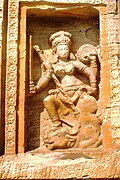
-

Ajanta Caves Fresco
Middle kingdoms and the Late Medieval menses (c. 600 CE – c. 1300 CE) [edit]
Over this period Hindu temple architecture matured into a number of regional styles, and a large proportion of the art historical tape for this period consists of temple sculpture, much of which remains in identify. The political history of the eye kingdoms of Bharat saw India divided into many states, and since much of the grandest building was commissioned past rulers and their court, this helped the development of regional differences. Painting, both on a large calibration on walls, and in miniature forms, was no doubt very widely practiced, merely survivals are rare. Medieval bronzes have nigh commonly survived from either the Tamil south, or the Himalayan foothills.
Dynasties of South India (c. 3rd century CE – c. 1300 CE) [edit]
Inscriptions on the Pillars of Ashoka mention coexistence of the northern kingdoms with the triumvirate of Chola, Chera and Pandya Tamil dynasties, situated south of the Vindhya mountains.[46] The medieval menses witnessed the rising and fall of these kingdoms, in conjunction with other kingdoms in the area. It is during the decline and resurgence of these kingdoms that Hinduism was renewed. Information technology fostered the construction of numerous temples and sculptures.
-

-

Youth in lotus pond, ceiling fresco at Sittanvasal, 850 CE
The Shore Temple at Mamallapuram constructed by the Pallavas symbolizes early Hindu compages, with its monolithic rock relief and sculptures of Hindu deities. They were succeeded by Chola rulers who were prolific in their pursuit of the arts. The Groovy Living Chola Temples of this period are known for their maturity, grandeur and attention to particular, and have been recognized as a UNESCO Heritage Site.[47] The Chola period is also known for its bronze sculptures, the lost-wax casting technique and fresco paintings. Thank you to the Hindu kings of the Chalukya dynasty, Jainism flourished aslope Islam evidenced by the fourth of the Badami cavern temples being Jain instead of Vedic. The kingdoms of Southward Republic of india continued to dominion their lands until the Muslim invasions that established sultanates there and destroyed much of the temples and curiosity examples of architectures and sculptures
Temples of Khajuraho (c. 800 CE – c. 1000 CE) [edit]

Recognized equally a UNESCO World Heritage Site,[48] the Khajuraho group of monuments were constructed by the Chandela clan of the Rajput dynasties. Apart from the usual Hindu temples, 10% of the sculptures depict twisted bodies of men and women that shed light on the everyday socio-cultural and religious practices in Medieval India. E'er since their discovery, the degree of sexuality depicted in these sculptures has drawn both negative and positive criticism from scholars.[49] [50] [ need quotation to verify ]
The Khajuraho temples were in active use nether Hindu kingdoms, until the establishment of the Delhi Sultanates of the 13th century. Nether Muslim rule until the 18th century, many of Khajuraho's monuments were destroyed, but a few ruins all the same remain.
Deccan [edit]
Other Hindu states are now mainly known through their surviving temples and their attached sculpture. These include Badami Chalukya architecture (5th to 6th centuries), Western Chalukya architecture (11th to 12th centuries) and Hoysala architecture (11th to 14th centuries), all centred on modern Karnataka.
Eastern Bharat [edit]
In east Bharat, Odisha and West Bengal, Kalinga architecture was the broad temple fashion, with local variants, before the Muslim conquest.
In antiquity, Bengal was a pioneer of painting in Asia nether the Pala Empire. Miniature and scroll painting flourished during the Mughal Empire. Kalighat painting or Kalighat Pat originated in the 19th century Bengal, in the vicinity of Kalighat Kali Temple of Kolkata, and from being items of souvenir taken by the visitors to the Kali temple, the paintings over a menses of time adult as a distinct schoolhouse of Indian painting. From the depiction of Hindu gods other mythological characters, the Kalighat paintings developed to reflect a variety of themes.
-

Rasmancha, Bishnupur. Built by Male monarch Bir Hambir, the temple has an unusual elongated pyramidical tower, surrounded by hut-shaped turrets, which were very typical of Bengali roof structures of the time.
-
-

-
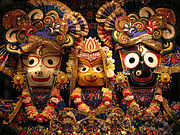
Early Modern and Colonial Era (c. 1400 CE – c. 1800 CE) [edit]
Mughal art [edit]
Although Islamic conquests in India were fabricated as early equally the commencement half of the 10th century, information technology wasn't until the Mughal Empire that 1 observes emperors with a patronage for the fine arts. Emperor Humayun, during his reestablishment of the Delhi Sultanate in 1555, brought with him Mir Sayyid Ali and Abd al-Samad, two of the finest painters from Persian Shah Tahmasp's renowned atelier.
During the reign of Akbar (1556—1605), the number of painters grew from around 30 during the creation of the Hamzanama in the mid-1560s, to around 130 by the mid 1590s.[51] According to court historian Abu'l-Fazal, Akbar was hands-on in his involvement of the arts, inspecting his painters regularly and rewarding the all-time.[52] Information technology is during this time that Persian artists were attracted to bringing their unique style to the empire. Indian elements were present in their works from the beginning, with the incorporation of local Indian flora and fauna that were otherwise absent from the traditional Persian way. The paintings of this time reflected the vibrancy and inclusion of Akbar'southward kingdom, with product of Western farsi miniatures, the Rajput paintings (including the Kangra school) and the Pahari fashion of Northern India. They also influenced the Company style watercolor paintings created during the British rule many years subsequently.
Mughal art of Northern Bharat (pre-1600) and its influences
-

Arghan Div Brings the Breast of Armor to Hamza, from Volume 7 of the Hamzanama, supervised by Samad, ca. 1562—1577. Opaque watercolor and gold on cotton.
-

Krishna playing flute, ca. 1790—1800, Guler/Kangra region. Opaque watercolor and gilt on paper.
With the death of Akbar, his son Jahangir (1605–1627) took the throne. He preferred each painter piece of work on a single slice rather than the collaboration fostered during Akbar's time. This period marks the emergence of distinct individual styles, notably Bishan Das, Manohar Das, Abu al-Hasan, Govardhan, and Daulat.[53] Jahangir himself had the adequacy to identify the work of each individual artist, even if the piece of work was unnamed. The Razmnama (Persian translation of the Hindu epic Mahabharata) and an illustrated memoir of Jahangir, named Tuzuk-i Jahangiri, were created nether his rule. Jahangir was succeeded by Shah Jahan (1628–1658), whose about notable architectural contribution is the Taj Mahal. Paintings nether his rule were more formal, featuring court scenes, in dissimilarity to the personal styles from his predecessor's fourth dimension. Aurangzeb (1658–1707), who held increasingly orthodox Sunni beliefs, forcibly took the throne from his male parent Shah Jahan. With a ban of music and painting in 1680, his reign saw the pass up of Mughal patronage of the arts.
As painting declined in the purple courtroom, artists and the general influence of Mughal painting spread to the princely courts and cities of n India, where both portraiture, the analogy of the Indian epics, and Hindu religious painting adult in many local schools and styles. Notable among these were the schools of Rajput, Pahari, Deccan, Kangra painting.
Mughal art of Northern India (post-1600)
-
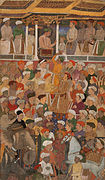
Jahangir in Darbar, from the Jahangir-nama, c. 1620. Gouache on paper.
-

Portrait of the emperor Shah Jahan, enthroned. ca. 17th century.
-

A durbar scene with the newly crowned Emperor Aurangzeb.
Other medieval Indian kingdoms [edit]
The concluding empire in southern India has left spectacular remains of Vijayanagara compages, especially at Hampi, Karnataka, frequently heavily decorated with sculpture. These developed the Chola tradition. After the Mughal conquest, the temple tradition continued to develop, mainly in the expansion of existing temples, which added new outer walls with increasingly large gopurams, oftentimes dwarfing the older buildings in the centre. These became normally thickly covered with plaster statues of deities and other religious figures, which demand have their brightly-coloured pigment kept renewed at intervals so they do not erode away.
In South-Central India, during the belatedly fifteenth century after the Middle kingdoms, the Bahmani sultanate disintegrated into the Deccan sultanates centered at Bijapur, Golconda, Ahmadnagar, Bidar, and Berar. They used vedic techniques of metal casting, rock carving, and painting, as well as a distinctive architectural style with the addition of citadels and tombs from Mughal compages. For case, the Baridi dynasty (1504–1619) of Bidar saw the invention of bidri ware, which was adopted from Vedic and Maurya period ashoka pillars of zinc mixed with copper, tin, and pb and inlaid with silver or brass, and then covered with a mud paste containing sal ammoniac, which turned the base of operations metal black, highlighting the colour and sheen of the inlaid metal. But after the Mughal conquest of Ahmadnagar in 1600 did the Farsi influence patronized by the Turco-Mongol Mughals begin to affect Deccan fine art.
Deccan art of South-Key India
-
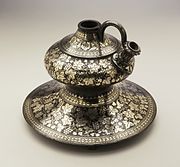
-

-

Portrait of Abu'l Hasan, the concluding Sultan of Golconda, c. late 17th—early 18th century
-

Chand Bibi hawking, an 18th-century Deccan painting, gouache heightened with gold on newspaper
British period (1841–1947) [edit]
British colonial rule had a peachy bear on on Indian fine art, especially from the mid-19th century onwards. Many erstwhile patrons of art became less wealthy and influential, and Western art more ubiquitous as the British Empire established schools of art in major cities. The oldest, the Government College of Fine Arts, Chennai, was established in 1850. In major cities with many Europeans, the Company fashion of small paintings became common, created by Indian artists working for European patrons of the Eastward India Company. The mode mainly used watercolour, to convey soft textures and tones, in a style combining influences from Western prints and Mughal painting.[54] By 1858, the British government took over the task of administration of India under the British Raj. Many commissions past Indian princes were now wholly or partly in Western styles, or the hybrid Indo-Saracenic architecture. The fusion of Indian traditions with European style at this time is evident from Raja Ravi Varma's oil paintings of sari-clad women in a graceful manner.
Pre-independence Indian art
Bengal School of Art [edit]
The Bengal Schoolhouse of Fine art commonly referred as Bengal Schoolhouse, was an fine art movement and a style of Indian painting that originated in Bengal, primarily Kolkata and Shantiniketan, and flourished throughout the Indian subcontinent, during the British Raj in the early 20th century. As well known every bit 'Indian fashion of painting' in its early on days, it was associated with Indian nationalism (swadeshi) and led past Abanindranath Tagore (1871-1951), but was likewise promoted and supported by British arts administrators like E. B. Havell, the principal of the Government Higher of Art and Craft, Kolkata from 1896; eventually it led to the development of the modern Indian painting.
Tagore after attempted to develop links with Japanese artists as part of an aspiration to construct a pan-Asianist model of art. Through the paintings of 'Bharat Mata', Abanindranath established the pattern of patriotism. Painters and artists of Bengal school were Nandalal Bose, M.A.R Chughtai, Sunayani Devi (sister of Abanindranath Tagore), Manishi Dey, Mukul Dey, Kalipada Ghoshal, Asit Kumar Haldar, Sudhir Khastgir, Kshitindranath Majumdar, Sughra Rababi.
Between 1920 and 1925, Gaganendranath pioneered experiments in modernist painting. Partha Mitter describes him every bit "the only Indian painter before the 1940s who made use of the language and syntax of Cubism in his painting". From 1925 onwards, the artist developed a circuitous post-cubist style.
With the Swadeshi Movement gaining momentum past 1905, Indian artists attempted to resuscitate the cultural identities suppressed by the British, rejecting the Romanticized style of the Visitor paintings and the mannered work of Raja Ravi Varma and his followers. Thus was created what is known today every bit the Bengal School of Art, led by the reworked Asian styles (with an emphasis on Indian nationalism) of Abanindranath Tagore (1871—1951), who has been referred to as the father of Modern Indian art.[55] Other artists of the Tagore family, such every bit Rabindranath Tagore (1861–1941) and Gaganendranath Tagore (1867–1938) besides as new artists of the early 20th century such as Amrita Sher-Gil (1913–1941) were responsible for introducing Advanced western styles into Indian Art. Many other artists similar Jamini Roy and later S.H. Raza took inspiration from folk traditions. In 1944, K.C.Southward. Paniker founded the Progressive Painters' Clan (PPA) thus giving ascension to the "madras movement" in art.[56]
-

Journey'due south End by Abanindranath Tagore.
-
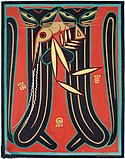
Two cats holding a big prawn by Jamini Roy.
-

Pratima Visarjan by Gaganendranath Tagore.
-
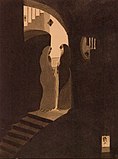
Gaganendranath Tagore - Coming together at the Staircase.
-

Fresco past Nandalal Bose in Dinantika - Ashram Complex - Santiniketan.
Contemporary art (c. 1900 CE-present) [edit]
In 1947, India became independent of British rule. A grouping of six artists - K. H. Ara, S. 1000. Bakre, H. A. Gade, K.F. Husain, South.H. Raza and Francis Newton Souza - founded the Bombay Progressive Artists' Group in the twelvemonth 1952, to establish new ways of expressing Bharat in the post-colonial era. Though the group was dissolved in 1956, it was greatly influential in changing the idiom of Indian fine art. Almost all India's major artists in the 1950s were associated with the group. Some of those who are well-known today are Bal Chabda, Manishi Dey, V. S. Gaitonde, Krishen Khanna, Ram Kumar, Tyeb Mehta, Yard. M. Subramanyan, A. Ramachandran, Devender Singh, Akbar Padamsee, John Wilkins, Himmat Shah and Manjit Bawa.[57] Present-day Indian art is varied as it had been never before. Amid the best-known artists of the newer generation include Bose Krishnamachari and Bikash Bhattacharjee. Another prominent Pakistani modernist was Ismail Gulgee, who after about 1960 adopted an abstruse idiom that combines aspects of Islamic calligraphy with an abstract expressionist (or gestural abstractionist) sensibility.
Painting and sculpture remained important in the later half of the twentieth century, though in the piece of work of leading artists such as Nalini Malani, Subodh Gupta, Narayanan Ramachandran, Vivan Sundaram, Jitish Kallat, Jamini Roy they often establish radical new directions. Bharti Dayal has called to handle the traditional Mithila painting in nigh contemporary way and created her ain style through the exercises of her own imagination, they appear fresh and unusual.
The increase in discourse about Indian fine art, in English besides equally vernacular Indian languages, inverse the way fine art was perceived in the art schools. Critical arroyo became rigorous; critics like Geeta Kapur, R. Siva Kumar,[58] [59] Shivaji G. Panikkar, Ranjit Hoskote, amongst others, contributed to re-thinking gimmicky art exercise in India.
-
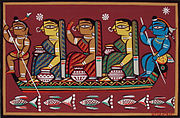
-

Pseudorealistic Indian painting. Couple, Kids and Confusion. by Devajyoti Ray.
-

Material history of Indian fine art [edit]
Sculpture [edit]
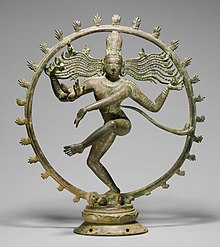
The first known sculpture in the Indian subcontinent is from the Indus Valley civilization (3300–1700 BC), found in sites at Mohenjo-daro and Harappa in modern-day Pakistan. These include the famous minor bronze male dancerNataraja. However such figures in statuary and stone are rare and greatly outnumbered by pottery figurines and stone seals, often of animals or deities very finely depicted. Later the collapse of the Indus Valley civilisation at that place is fiddling tape of sculpture until the Buddhist era, apart from a hoard of copper figures of (somewhat controversially) c. 1500 BCE from Daimabad.[60] Thus the slap-up tradition of Indian monumental sculpture in rock appears to begin relatively late, with the reign of Ashoka from 270 to 232 BCE, and the Pillars of Ashoka he erected around India, conveying his edicts and topped by famous sculptures of animals, mostly lions, of which six survive.[61] Large amounts of figurative sculpture, mostly in relief, survive from Early on Buddhist pilgrimage stupas, in a higher place all Sanchi; these probably developed out of a tradition using wood.[62] Indeed, wood continued to exist the chief sculptural and architectural medium in Kerala throughout all historic periods until recent decades.[63]
During the second to 1st century BCE in far northern India, in the Greco-Buddhist art of Gandhara from what is at present southern Afghanistan and northern Islamic republic of pakistan, sculptures became more explicit, representing episodes of the Buddha's life and teachings. Although India had a long sculptural tradition and a mastery of rich iconography, the Buddha was never represented in man class before this time, but but through some of his symbols. This may exist because Gandharan Buddhist sculpture in modern Afghanistan displays Greek and Persian artistic influence. Artistically, the Gandharan schoolhouse of sculpture is said to accept contributed wavy hair, drape roofing both shoulders, shoes and sandals, acanthus leaf decorations, etc.
The pinkish sandstone Hindu, Jain and Buddhist sculptures of Mathura from the 1st to 3rd centuries CE reflected both native Indian traditions and the Western influences received through the Greco-Buddhist art of Gandhara, and effectively established the basis for subsequent Indian religious sculpture.[62] The way was developed and diffused through nigh of India under the Gupta Empire (c. 320-550) which remains a "classical" period for Indian sculpture, covering the earlier Ellora Caves,[64] though the Elephanta Caves are probably slightly later.[65] After large calibration sculpture remains nigh exclusively religious, and more often than not rather conservative, oft reverting to simple frontal continuing poses for deities, though the attendant spirits such every bit apsaras and yakshi oft have sensuously curving poses. Carving is often highly detailed, with an intricate backing backside the main figure in high relief. The celebrated lost wax bronzes of the Chola dynasty (c. 850–1250) from south India, many designed to exist carried in processions, include the iconic class of Shiva every bit Nataraja,[66] with the massive granite carvings of Mahabalipuram dating from the previous Pallava dynasty.[67] The Chola period is too remarkable for its sculptures and bronzes.[68] Amid the existing specimens in the diverse museums of the world and in the temples of South India may be seen many fine figures of Siva in various forms, Vishnu and his wife Lakshmi, Siva saints and many more.[69]
Wall painting [edit]

The tradition and methods of Indian cliff painting gradually evolved throughout many thousands of years - at that place are multiple locations institute with prehistoric art. The early caves included overhanging rock decorated with rock-cut fine art and the use of natural caves during the Mesolithic period (6000 BCE). Their utilise has connected in some areas into celebrated times.[70] The Rock Shelters of Bhimbetka are on the edge of the Deccan Plateau where deep erosion has left huge sandstone outcrops. The many caves and grottos found there comprise primitive tools and decorative rock paintings that reflect the aboriginal tradition of human interaction with their landscape, an interaction that continues to this day.[71]
The oldest surviving frescoes of the historical flow have been preserved in the Ajanta Caves with Cave 10 having some from the 1st century CE, though the larger and more famous groups are from the 5th century. Despite climatic conditions that tend to piece of work confronting the survival of older paintings, in total there are known more than 20 locations in India with paintings and traces of former paintings of aboriginal and early medieval times (upwardly to the 8th to 10th centuries CE),[72] although these are merely a tiny fraction of what would accept once existed. The most significant frescoes of the ancient and early medieval period are found in the Ajanta, Bagh, Ellora, and Sittanavasal caves, the last being Jain of the 7th-10th centuries. Although many show evidence of being by artists mainly used to decorating palaces, no early secular wall-paintings survive.[73]
The Chola fresco paintings were discovered in 1931 within the circumambulatory passage of the Brihadisvara Temple at Thanjavur, Tamil Nadu, and are the commencement Chola specimens discovered. Researchers accept discovered the technique used in these frescoes. A smooth batter of limestone mixture is applied over the stones, which took two to three days to gear up. Within that brusk span, such large paintings were painted with natural organic pigments. During the Nayak period the Chola paintings were painted over. The Chola frescoes lying underneath have an ardent spirit of saivism is expressed in them. They probably synchronised with the completion of the temple by Rajaraja Cholan the Cracking.
Kerala mural painting has well-preserved fresco or mural or wall painting in temple walls in Pundarikapuram, Ettumanoor and Aymanam and elsewhere.
Miniature painting [edit]

Akbar riding the elephant Hawa'I pursuing another elephant
Although few Indian miniatures survive from before about 1000 CE, and some from the adjacent few centuries, there was probably a considerable tradition. Those that survive are initially illustrations for Buddhist texts, later followed by Jain and Hindu equivalents, and the decline of Buddhist too as the vulnerable back up material of the palm-leafage manuscript probably explain the rarity of early on examples.[74]
Mughal painting in miniatures on paper developed very quickly in the late 16th century from the combined influence of the existing miniature tradition and artists trained in the Persian miniature tradition imported by the Mughal Emperor'southward courtroom. New ingredients in the style were much greater realism, especially in portraits, and an interest in animals, plants and other aspects of the physical world.[75] Deccan painting developed around the same time in the Deccan sultanates courts to the south, in some ways more vital, if less poised and elegant.[76]
Miniatures either illustrated books or were single works for muraqqas or albums of painting and Islamic calligraphy. The style gradually spread in the next two centuries to influence painting on paper in both Muslim and Hindu princely courts, developing into a number of regional styles often called "sub-Mughal", including Rajput painting, Pahari painting, and finally Visitor painting, a hybrid watercolour style influenced by European art and largely patronized by the people of the British raj. In "pahari" ("mount") centres similar that of Kangra painting the style remained vital and connected to develop into the early decades of the 19th century.[77] From the mid-19th century Western-style easel paintings became increasingly painted by Indian artists trained in Regime art schools.
Jewellery [edit]

The Indian subcontinent has the longest continuous legacy of jewellery-making, with a history of over 5,000 years.[78] Using jewellery as a store of majuscule remains more common in India than in most mod societies, and gold appears always to have been strongly preferred for the metal. India and the surrounding areas were important sources of loftier-quality gemstones, and the jewellery of the ruling grade is typified by using them lavishly. I of the starting time to start jewellery-making were the people of the Indus Valley Civilisation. Early on remains are few, every bit they were non buried with their owners.
Other materials [edit]
Woods was undoubtedly extremely important, simply rarely survives long in the Indian climate. Organic animal materials such as ivory or bone were discouraged past the Dharmic religions, although Buddhist examples exist, such every bit the Begram ivories, many of Indian manufacture, simply found in Afghanistan, and some relatively modern carved tusks. In Muslim settings they are more than common.
Contextual history of Indian fine art [edit]
Temple fine art [edit]
Obscurity shrouds the catamenia between the decline of the Harappans and the definite celebrated period starting with the Mauryas, and in the historical flow, the earliest Indian religion to inspire major artistic monuments was Buddhism. Though there may have been before structures in wood that have been transformed into rock structures, there are no physical evidences for these except textual references. Soon after the Buddhists initiated rock-cut caves, Hindus and Jains started to imitate them at Badami, Aihole, Ellora, Salsette, Elephanta, Aurangabad and Mamallapuram and Mughals. Information technology appears to be a abiding in Indian art that the different religions shared a very like artistic mode at any particular period and place, though naturally adapting the iconography to match the religion commissioning them.[79] Probably the aforementioned groups of artists worked for the different religions regardless of their ain affiliations.

Buddhist art first developed during the Gandhara period and Amaravati Periods effectually the 1st century BCE. It flourished greatly during the Gupta Periods and Pala Periods that incorporate the Golden Age of India. Although the most glorious art of these Indian empires was mostly Buddhist in nature, afterwards Hindu Empires like the Pallava, Chola, Hoysala and Vijayanagara Empires adult their own styles of Hindu art too.
There is no time line that divides the creation of rock-cut temples and free-standing temples built with cutting rock as they developed in parallel. The edifice of free-continuing structures began in the fifth century, while rock-cut temples continued to be excavated until the 12th century. An example of a free-standing structural temple is the Shore Temple, a role of the Mahabalipuram Globe Heritage Site, with its slender tower, congenital on the shore of the Bay of Bengal with finely carved granite rocks cutting like bricks and dating from the eighth century.[eighty] [81]
Folk and tribal art [edit]
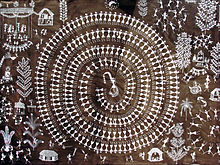
Folk and tribal art in Bharat takes on different manifestations through varied media such every bit pottery, painting, metalwork,[82] newspaper-art, weaving and designing of objects such as jewellery and toys. These are not simply aesthetic objects but in fact have an of import significance in people's lives and are tied to their beliefs and rituals. The objects can range from sculpture, masks (used in rituals and ceremonies), paintings, textiles, baskets, kitchen objects, arms and weapons, and the human body itself (tattoos and piercings). There is a deep symbolic meaning that is attached to not only the objects themselves but also the materials and techniques used to produce them.
Oft puranic gods and legends are transformed into contemporary forms and familiar images. Fairs, festivals, local heroes (mostly warriors) and local deities play a vital role in these arts (Example: Nakashi art from Telangana or Cherial Whorl Painting).
Folk art also includes the visual expressions of the wandering nomads. This is the fine art of people who are exposed to changing landscapes as they travel over the valleys and highlands of India. They carry with them the experiences and memories of unlike spaces and their art consists of the transient and dynamic pattern of life. The rural, tribal and arts of the nomads plant the matrix of folk expression. Examples of folk arts are Warli, Madhubani Art, Manjusha Art, Tikuli Art, Gond art and Bhil fine art etc.
While most tribes and traditional folk artist communities are assimilated into the familiar kind of civilised life, they still continue to practice their art. Unfortunately though, market and economical forces have ensured that the numbers of these artists are dwindling.[83] [84] A lot of effort is existence fabricated by diverse NGOs and the Government of India to preserve and protect these arts and to promote them. Several scholars in Bharat and across the world have studied these arts and some valuable scholarship is bachelor on them.
The folk spirit has a tremendous role to play in the development of art and in the overall consciousness of indigenous cultures.
Contextual Modernism [edit]
The year 1997 diameter witness to two parallel gestures of canon formation. On the one manus, the influential Baroda Group, a coalition whose original members included Vivan Sundaram, Ghulam Mohammed Sheikh, Bhupen Khakhar, and Nalini Malani—and which had left its mark on history in the class of the 1981 exhibition "Identify for People"—was definitively historicized in 1997 with the publication of Gimmicky Fine art in Baroda, an anthology of essays edited by Sheikh. On the other hand, the art historian R. Siva Kumar'south benchmark exhibition and related publication, A Contextual Modernism, restored the Santiniketan artists—Rabindranath Tagore, Nandalal Bose, Benode Behari Mukherjee, and Ramkinkar Baij—to their proper place every bit the originators of an indigenously achieved all the same transcultural modernism in the 1930s, well before the Progressives composed their manifesto in the tardily 1940s. Of the Santiniketan artists, Siva Kumar observed that they "reviewed traditional antecedents in relation to the new avenues opened up past cantankerous-cultural contacts. They also saw information technology as a historical imperative. Cultural insularity, they realized, had to give fashion to eclecticism and cultural impurity."[85]

The idea of Contextual Modernism emerged in 1997 from R. Siva Kumar'due south Santiniketan: The Making of a Contextual Modernism as a postcolonial critical tool in the understanding of an culling modernism in the visual arts of the one-time colonies like India, specifically that of the Santiniketan artists.
Several terms including Paul Gilroy'southward counter culture of modernity and Tani Barlow's Colonial modernity accept been used to draw the kind of alternative modernity that emerged in non-European contexts. Professor Gall argues that 'Contextual Modernism' is a more suited term because "the colonial in colonial modernity does not conform the refusal of many in colonized situations to internalize inferiority. Santiniketan's artist teachers' refusal of subordination incorporated a counter vision of modernity, which sought to correct the racial and cultural essentialism that drove and characterized imperial Western modernity and modernism. Those European modernities, projected through a triumphant British colonial power, provoked nationalist responses, equally problematic when they incorporated similar essentialisms."[86]
According to R. Siva Kumar "The Santiniketan artists were ane of the outset who consciously challenged this thought of modernism past opting out of both internationalist modernism and historicist indigenousness and tried to create a context sensitive modernism."[87] He had been studying the piece of work of the Santiniketan masters and thinking near their approach to art since the early 80s. The practice of subsuming Nandalal Bose, Rabindranath Tagore, Ram Kinker Baij and Benode Behari Mukherjee nether the Bengal School of Fine art was, co-ordinate to Siva Kumar, misleading. This happened because early writers were guided by genealogies of apprenticeship rather than their styles, worldviews, and perspectives on art exercise.[87]
Contextual Modernism in the contempo by has found its usage in other related fields of studies, particularly in Compages.[88]
Art museums of India [edit]
Major cities [edit]
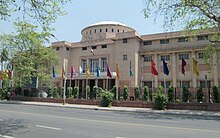


- National Museum, New Delhi
- Chhatrapati Shivaji Maharaj Vastu Sangrahalaya (CSMVS), Mumbai (formerly Prince of Wales Museum of Western India)
- Indian Museum, Kolkata
- Salar Jung Museum, Hyderabad
- Government Museum (Bangalore)
- Government Museum, Chennai
- Government Museum and Art Gallery, Chandigarh


Archaeological museums [edit]
- AP Country Archeology Museum, Hyderabad
- Archaeological Museum, Thrissur
- City Museum, Hyderabad
- Government Museum, Mathura
- Government Museum, Tiruchirappalli
- Loma Palace, Tripunithura, Ernakulam
- Odisha State Museum, Bhubaneswar
- Patna Museum
- Pazhassi Raja Archaeological Museum, Kozhikode
- Sanghol Museum
- Sarnath Museum
- Land Archaeological Gallery, Kolkata
- Victoria Jubilee Museum, Vijayawada
Modern art museums [edit]
- National Gallery of Modern Art, New Delhi - established 1954.
- National Gallery of Modern Art, Mumbai - established 1996.
- National Gallery of Modernistic Art, Bangalore - inaugurated 2009.
- Kolkata Museum of Modern Fine art - foundation laid in 2013.
Other museums [edit]
- Albert Hall Museum, Jaipur
- Allahabad Museum
- Asutosh Museum of Indian Art, Kolkata
- Baroda Museum & Film Gallery
- Goa State Museum, Panaji
- Napier Museum, Thiruvananthapuram
- National Handicrafts and Handlooms Museum, New Delhi
- Sanskriti Museums, Delhi
- Watson Museum, Rajkot
- Srimanthi Bai Memorial Regime Museum, Mangalore
See too [edit]
- Indian painting
- Government College of Fine Arts, Chennai
- Indian compages
- Indian vernacular architecture
- Crafts of Republic of india
- Rasa (art)
Notes [edit]
- ^ Jagadish Gupta (1996). Pre-celebrated Indian Painting. North Fundamental Zone Cultural Heart.
- ^ Shiv Kumar Tiwari (ane Jan 2000s). Riddles of Indian Rockshelter Paintings. Sarup & Sons. pp. viii–. ISBN978-81-7625-086-3.
- ^ Cockburn, John (1899). "Art. 5.—Cave Drawings in the Kaimūr Range, Northward-West Provinces". Journal of the Regal Asiatic Society of Groovy Britain & Ireland. New Series. 31 (ane): 89–97. doi:10.1017/S0035869X00026113.
- ^ Mathpal, Yashodhar (1984). Prehistoric Painting Of Bhimbetka. Abhinav Publications. p. 220. ISBN9788170171935.
- ^ Tiwari, Shiv Kumar (2000). Riddles of Indian Rockshelter Paintings. Sarup & Sons. p. 189. ISBN9788176250863.
- ^ Rock Shelters of Bhimbetka (PDF). UNESCO. 2003. p. 16.
- ^ Mithen, Steven (2011). Afterwards the Ice: A Global Homo History, 20,000 - 5000 BC. Orion. p. 524. ISBN9781780222592.
- ^ Javid, Ali; Jāvīd, ʻAlī; Javeed, Tabassum (2008). World Heritage Monuments and Related Edifices in India. Algora Publishing. p. 19. ISBN9780875864846.
- ^ Pathak, Dr. Meenakshi Dubey. "Indian Rock Fine art - Prehistoric Paintings of the Pachmarhi Hills". Bradshaw Foundation. Retrieved 7 November 2014.
- ^ Marshall, Sir John. Mohenjo-Daro and the Indus Civilisation, three vols, London: Arthur Probsthain, 1931
- ^ Keay, John, Bharat, a History. New York: Grove Press, 2000.
- ^ Harle, 15-19
- ^ Harle, xix-20
- ^ a b Paul, Pran Gopal; Paul, Debjani (1989). "Brahmanical Imagery in the Kuṣāṇa Art of Mathurā: Tradition and Innovations". E and West. 39 (1/4): 111–143, especially 112–114, 115, 125. JSTOR 29756891.
- ^ Paul, Pran Gopal; Paul, Debjani (1989). "Brahmanical Imagery in the Kuṣāṇa Fine art of Mathurā: Tradition and Innovations". East and Westward. 39 (1/4): 111–143. ISSN 0012-8376. JSTOR 29756891.
- ^ Krishan, Yuvraj; Tadikonda, Kalpana K. (1996). The Buddha Paradigm: Its Origin and Development. Bharatiya Vidya Bhavan. p. ix-x. ISBN978-81-215-0565-ix.
- ^ a b c d Shaw, Ian; Jameson, Robert (2008). A Dictionary of Archaeology. John Wiley & Sons. p. 248. ISBN978-0-470-75196-ane.
- ^ Harle, 22-28
- ^ Harle, 22-26
- ^ Land Emblem Archived May 11, 2012, at the Wayback Car, Know Bharat india.gov.in
- ^ Harle, 39-42
- ^ Dated 100 BCE in Fig.88 in Quintanilla, Sonya Rhie (2007). History of Early Stone Sculpture at Mathura: Ca. 150 BCE - 100 CE. BRILL. p. 368, Fig. 88. ISBN9789004155374.
- ^ a b c d due east f Dalal, Roshen (2010). The Religions of India: A Concise Guide to Ix Major Faiths. Penguin Books India. pp. 397–398. ISBN978-0-fourteen-341517-half-dozen.
- ^ Singh, Upinder (2008). A History of Aboriginal and Early Medieval India. New Delhi: Pearson Education. p. 430. ISBN978-81-317-1120-0.
- ^ "yaksha". Encyclopædia Britannica. Retrieved fifteen July 2007.
- ^ Sharma, Ramesh Chandra (1994). The Splendour of Mathurā Art and Museum. D.M. Printworld. p. 76. ISBN978-81-246-0015-iii.
- ^ a b c d due east Boardman, John (1993). The Diffusion of Classical Art in Artifact. Princeton University Press. p. 112. ISBN0691036802.
- ^ Fig. 85 in Quintanilla, Sonya Rhie (2007). History of Early Rock Sculpture at Mathura: Ca. 150 BCE - 100 CE. BRILL. p. Fig.85, p.365. ISBN9789004155374.
- ^ "The folk art typifies an older plastic tradition in clay and woods which was at present put in stone, as seen in the massive Yaksha statuary which are also of exceptional value as models of subsequent divine images and human figures." in Agrawala, Vasudeva Sharana (1965). Indian Art: A history of Indian art from the primeval times up to the third century A. D. Prithivi Prakashan. p. 84.
- ^ "With respect to large-calibration iconic statuary carved in the circular (...) the region of Mathura not only rivaled other areas but surpassed them in overall quality and quantity throughout the second and early kickoff century BCE." in Quintanilla, Sonya Rhie (2007). History of Early Stone Sculpture at Mathura: Ca. 150 BCE - 100 CE. BRILL. p. 24. ISBN9789004155374.
- ^ Quintanilla, Sonya Rhie (2007). History of Early Stone Sculpture at Mathura: Ca. 150 BCE - 100 CE. BRILL. pp. 23–25. ISBN9789004155374.
- ^ Harle, 105-117, 26-47
- ^ Harle, 59-70
- ^ Harle, 105-117, 71-84 on Gandhara
- ^ Harle, 68-seventy (merely see p. 253 for another exception)
- ^ a b c Stokstad, Marilyn (2018). Art History. United States: Pearson Didactics. pp. 306–310. ISBN9780134475882.
- ^ Department of Asian Fine art (2000). "Shunga Dynasty (ca. Second - Offset Century B.C.)". Retrieved November 26, 2018.
- ^ "Indian subcontinent". Oxford Art Online. 2003. Retrieved Dec 3, 2018.
- ^ Sarkar (2006). Hari smriti. New Delhi : Kaveri Books. p. 73. ISBN8174790756.
- ^ a b Sarma, I.Yard (2001). Sri Subrahmanya Smrti. New Delhi : Sundeep Prakashan. pp. 283–290. ISBN8175741023.
- ^ Nārāyaṇa Rāya, Udaya (2006). Art, archæology, and cultural history of India. Delhi : B.R. Pub. Corp. ISBN8176464929.
- ^ Xinru Liu, The Silk Road in World History, New York: Oxford University Press, 2010, 42.
- ^ Lolita Nehru, Origins of the Gandharan Style, p. 63.
- ^ Chakravarti, Ranabir (2016-01-11), "Kushan Empire", The Encyclopedia of Empire, John Wiley & Sons, Ltd, pp. one–half dozen, doi:x.1002/9781118455074.wbeoe147, ISBN9781118455074
- ^ Michaels, Axel (2004). Hinduism: Past and Present. Princeton University Press. p. forty. ISBN978-0-691-08953-nine.
- ^ Dhammika, Ven. S. (1994). "The Edicts of King Ashoka (an English language rendering)". DharmaNet International. Archived from the original on March 28, 2014. Retrieved 22 November 2014.
... Love-of-the-Gods, King Piyadasi'southward domain, and amidst the people across the borders, the Cholas, the Pandyas, ...
- ^ "Great Living Chola Temples". UNESCO. 1987. Retrieved 22 November 2014.
- ^ "Khajuraho Group of Monuments". UNESCO Earth Heritage List. UNESCO. 1986. Retrieved eight November 2014.
- ^ Panikkar, M. M. (1955). "Presidential Address". Indian History Congress. Vol. 18th Session. Calcutta.
- ^ Dehejia, Vidya (1997). Representing the Torso: Gender Issues in Indian Art. Delhi: Kali for Women (Women Unlimited). ISBN978-81-85107-32-5.
- ^ Seyller, John (1987). "Scribal Notes on Mughal Manuscript Illustrations". Artibus Asiae. 48 (3/4): 247–277. doi:10.2307/3249873. JSTOR 3249873.
- ^ Fazl, Abu'l (1927). Ain-i Akbari. Translated by H Blochmann. Asiatic Social club of Bengal.
- ^ "Daulat". Encyclopædia Britannica . Retrieved 13 November 2014.
- ^ George Michell; Catherine Lampert; Tristram The netherlands (1982). In the Image of Man: The Indian Perception of the Universe Through 2000 Years of Painting and Sculpture. Alpine Fine Arts Collection. ISBN978-0-933516-52-6.
- ^ Hachette India (25 October 2013). Indiapedia: The All-Republic of india Factfinder. Hachette India. pp. 130–. ISBN978-93-5009-766-iii.
- ^ "For art's sake". The Hindu. February 12, 2009. Archived from the original on May 25, 2011. Retrieved Nov 23, 2014.
- ^ "Showcase – Artists Collectives". National Gallery of Modernistic Art, New Delhi. 2012-11-09. Retrieved 2014-11-23 .
- ^ "National Gallery of Modern Art, New Delhi".
- ^ "Rabindranath Tagore: The Terminal Harvest".
- ^ Harle, 17–20
- ^ Harle, 22–24
- ^ a b Harle, 26–38
- ^ Harle, 342-350
- ^ Harle, 87; his Part 2 covers the period
- ^ Harle, 124
- ^ Harle, 301-310, 325-327
- ^ Harle, 276–284
- ^ Chopra. et al., p. 186.
- ^ Tri. [Championship needed]. p. 479.
- ^ "Prehistoric Rock Art". art-and-archaeology.com. Retrieved 2006-10-17 .
- ^ "Rock Shelters of Bhimbetka". Retrieved 2006-12-xx .
- ^ "Aboriginal and medieval Indian cave paintings - Internet encyclopedia". Wondermondo. 2010-06-10. Retrieved 2010-06-04 .
- ^ Harle, 355
- ^ Harle, 361-366
- ^ Harle, 372-382
- ^ Harle, 400-406
- ^ Harle, 407-420
- ^ Untracht, Oppi. Traditional Jewelry of Republic of india. New York: Abrams, 1997 ISBN 0-8109-3886-three. p15.
- ^ Harle, 59
- ^ Thapar, Binda (2004). Introduction to Indian Architecture. Singapore: Periplus Editions. pp. 36–37, 51. ISBN978-0-7946-0011-2.
- ^ "Architecture of the Indian Subcontinent". Retrieved 2006-12-21 .
- ^ dhokra art Archived 2010-12-29 at the Wayback Machine
- ^ GVSS, Gramin Vikas Seva Sanshtha (12 June 2011). "Evaluation Written report of Tribal/Folk Arts and Culture in West Bengal, Orissa, Jharkhand, Chhatisgarh and Bihar" (PDF). Planning Commission. Socio-Economic Research (SER) Division, Planning Commission, Govt. of Republic of india New Delhi. p. 53. Retrieved 2 March 2015.
... globalization has triggered the emergence of a constructed macro-civilisation...is gaining popularity twenty-four hour period by mean solar day and silently engineering the gradual attrition of tribal/folk art and culture.
- ^ "Refuse of tribal and folk arts lamented". Deccan Herald. Gudibanda, Karnataka, Republic of india. 3 July 2008. Archived from the original on 2 March 2015. Retrieved 2 March 2015.
In the wave of electronic media, our ... ancient civilisation and tribal art accept been declining, ..., said sociology researcher J Srinivasaiah.
- ^ Hapgood, Susan; Hoskote, Ranjit (2015). "Abby Grey And Indian Modernism" (PDF). Grey Art Gallery. New York: New York University. Archived from the original (PDF) on 3 Jan 2016. Retrieved 12 March 2021.
- ^ Gall, David. "Overcoming Polarized Modernities: Counter-Mod Fine art Education: Santiniketan1Overcoming Polarized Modernities: Counter-Modernistic Art Education: Santiniketan,The Legacy of a Poet's Schoolhouse" (PDF). Hawaii Academy International Conferences . Retrieved 12 March 2021.
- ^ a b "Humanities cloak-and-dagger » All the Shared Experiences of the Lived World II".
- ^ ""Contextual modernism" – is information technology possible? Steps to improved housing strategy". 2011.
References [edit]
- Harle, J.C., The Art and Architecture of the Indian Subcontinent, 2nd edn. 1994, Yale Academy Press Pelican History of Art, ISBN 0300062176
- Harsha V. Dehejia, The Advaita of Art (Delhi: Motilal Banarsidass, 2000, ISBN 81-208-1389-eight), p. 97
- Kapila Vatsyayan, Classical Indian Dance in Literature and the Arts (New Delhi: Sangeet Natak Akademi, 1977), p. viii
- Mitter, Partha. Indian Art (Oxford: Oxford Academy Press, 2001, ISBN 0-19-284221-eight)
Farther reading [edit]
- Gupta, S. P., & Asthana, S. P. (2007). Elements of Indian art: Including temple architecture, iconography & iconometry. New Delhi: Indraprastha Museum of Art and Archaeology.
- Gupta, Due south. P., & Shastri Indo-Canadian Institute. (2011). The roots of Indian art: A detailed study of the formative period of Indian fine art and architecture, third and second centuries B.C., Mauryan and late Mauryan. Delhi: B.R. Publishing Corporation.
- Abanindranath Tagore (1914). Some Notes on Indian Artistic Anatomy. Indian Society of Oriental Art, Calcutta. OL 6213535M.
- Kossak, Steven (1997). Indian courtroom painting, 16th-19th century. . New York: The Metropolitan Museum of Art. ISBN978-0870997839. (meet index: pages 148-152)
- Lerner, Martin (1984). The flame and the lotus: Indian and Southeast Asian fine art from the Kronos collections . New York: The Metropolitan Museum of Art. ISBN978-0870993749. fully online
- Smith, Vincent A. (1930). A History Of Fine Art In Bharat And Ceylon. The Clarendon Press, Oxford.
- Welch, Stuart Cary (1985). Republic of india: art and culture, 1300-1900 . New York: The Metropolitan Museum of Art. ISBN9780944142134. fully online
Source: https://en.wikipedia.org/wiki/Indian_art
